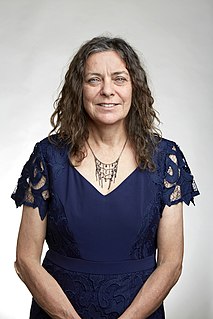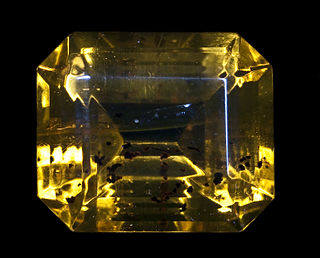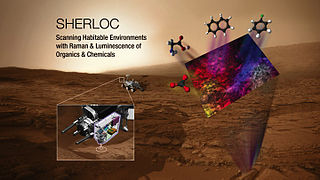Related Research Articles

Geomicrobiology is the scientific field at the intersection of geology and microbiology and is a major subfield of geobiology. It concerns the role of microbes on geological and geochemical processes and effects of minerals and metals to microbial growth, activity and survival. Such interactions occur in the geosphere, the atmosphere and the hydrosphere. Geomicrobiology studies microorganisms that are driving the Earth's biogeochemical cycles, mediating mineral precipitation and dissolution, and sorbing and concentrating metals. The applications include for example bioremediation, mining, climate change mitigation and public drinking water supplies.
A biosignature is any substance – such as an element, isotope, or molecule – or phenomenon that provides scientific evidence of past or present life. Measurable attributes of life include its complex physical or chemical structures and its use of free energy and the production of biomass and wastes. A biosignature can provide evidence for living organisms outside the Earth and can be directly or indirectly detected by searching for their unique byproducts.

Nakhla is a Martian meteorite which fell in Egypt in 1911. It was the first meteorite reported from Egypt, the first one to suggest signs of aqueous processes on Mars, and the prototype for Nakhlite type of meteorites.

Jillian Fiona Banfield is Professor at the University of California, Berkeley with appointments in the Earth Science, Ecosystem Science and Materials Science and Engineering departments. She leads the Microbial Research initiative within the Innovative Genomics Institute, is affiliated with Lawrence Berkeley National Laboratory and has a position at the University of Melbourne, Australia. Some of her most noted work includes publications on the structure and functioning of microbial communities and the nature, properties and reactivity of nanomaterials.
The Deep Carbon Observatory (DCO) is a global research program designed to transform understanding of carbon's role in Earth. DCO is a community of scientists, including biologists, physicists, geoscientists and chemists, whose work crosses several traditional disciplinary lines to develop the new, integrative field of deep carbon science. To complement this research, the DCO's infrastructure includes public engagement and education, online and offline community support, innovative data management, and novel instrumentation development.

An organic mineral is an organic compound in mineral form. An organic compound is any compound containing carbon, aside from some simple ones discovered before 1828. There are three classes of organic mineral: hydrocarbons, salts of organic acids, and miscellaneous. Organic minerals are rare, and tend to have specialized settings such as fossilized cacti and bat guano. Mineralogists have used statistical models to predict that there are more undiscovered organic mineral species than known ones.

Scanning Habitable Environments with Raman and Luminescence for Organics and Chemicals (SHERLOC) is an ultraviolet Raman spectrometer that uses fine-scale imaging and an ultraviolet (UV) laser to determine fine-scale mineralogy, and detect organic compounds designed for the Perseverance rover as part of the Mars 2020 mission. It was constructed at the Jet Propulsion Laboratory with major subsystems being delivered from Malin Space Science Systems and Los Alamos National Laboratory. The Principal Investigator is Luther Beegle, and the Deputy Principal Investigator is Rohit Bhartia.
Katrina Jane Edwards was a pioneering geomicrobiologist known for her studies of organisms living below the ocean floor, specifically exploring the interactions between the microbes and their geological surroundings, and how global processes were influenced by these interactions. She spearheaded the Center for Dark Energy Biosphere Investigation (C-DEBI) project at the University of Southern California, which is ongoing. Edwards also helped organize the deep biosphere research community by heading the Fe-Oxidizing Microbial Observatory Project on Loihi Seamount, and serving on several program steering committees involving ocean drilling. Edwards taught at the Woods Hole Oceanographic Institution (WHOI) and later became a professor at the University of Southern California.[1][2]
The Carbon Mineral Challenge is a citizen science project dedicated to accelerating the discovery of carbon-bearing minerals. The program launched in 2015 December with sponsorship from the Deep Carbon Observatory. The project ended in 2019 September, with 31 new carbon-bearing minerals found from 27 locations.
Marie Edmonds is a Professor of volcanology and geology at the University of Cambridge whose research focuses on the physics and chemistry of volcanic eruptions and magmatism and understanding volatile cycling in the solid Earth as mediated by plate tectonics. She is interested in the social and economic impacts of natural hazards; and the sustainable use of Earth's mineral and energy resources. Professor Edmonds is the Vice President and Ron Oxburgh Fellow in Earth Sciences at Queens' College, Cambridge; and the Deputy Head of Department and Director of Research at the Earth Sciences Department, University of Cambridge.
Craig E. Manning is a professor of geology and geochemistry in the Department of Earth, Planetary, and Space Sciences at the University of California, Los Angeles, where he served as department chair between 2009 and 2012. Manning's research interests include water chemistry, thermodynamics, gas chemistry, geochemistry, igneous petrology, and metamorphic petrology.
Dr. Jie (Jackie) Li is a scientist and Professor at the University of Michigan.
Dr. Mitchell Sogin is a distinguished senior scientist at the Marine Biological Laboratory in Woods Hole, Massachusetts, whose research investigates the evolution and diversity of single-celled organisms.

Mark Alexander Lever is a microbial ecologist who studies the role of microorganisms in the global carbon cycle. He is a professor of environmental microbiology in the Department of Environmental Systems Science in the Institute of Biogeochemical and Pollutant Dynamics at ETH Zurich.
Frederick (Rick) Colwell is a microbial ecologist specializing in subsurface microbiology and geomicrobiology. He is a professor of ocean ecology and biogeochemistry at Oregon State University, and an adjunct and affiliate faculty member at Idaho State University.
The geochemistry of carbon is the study of the transformations involving the element carbon within the systems of the Earth. To a large extent this study is organic geochemistry, but it also includes the very important carbon dioxide. Carbon is transformed by life, and moves between the major phases of the Earth, including the water bodies, atmosphere, and the rocky parts. Carbon is important in the formation of organic mineral deposits, such as coal, petroleum or natural gas. Most carbon is cycled through the atmosphere into living organisms and then respirated back into the atmosphere. However an important part of the carbon cycle involves the trapping of living matter into sediments. The carbon then becomes part of a sedimentary rock when lithification happens. Human technology or natural processes such as weathering, or underground life or water can return the carbon from sedimentary rocks to the atmosphere. From that point it can be transformed in the rock cycle into metamorphic rocks, or melted into igneous rocks. Carbon can return to the surface of the Earth by volcanoes or via uplift in tectonic processes. Carbon is returned to the atmosphere via volcanic gases. Carbon undergoes transformation in the mantle under pressure to diamond and other minerals, and also exists in the Earth's outer core in solution with iron, and may also be present in the inner core.

Mineral evolution is a recent hypothesis that provides historical context to mineralogy. It postulates that mineralogy on planets and moons becomes increasingly complex as a result of changes in the physical, chemical and biological environment. In the Solar System, the number of mineral species has grown from about a dozen to over 5400 as a result of three processes: separation and concentration of elements; greater ranges of temperature and pressure coupled with the action of volatiles; and new chemical pathways provided by living organisms.
Raman Laser Spectrometer (RLS) is a miniature Raman spectrometer that is part of the science payload on board the European Space Agency'sRosalind Franklin rover, tasked to search for biosignatures and biomarkers on Mars. The rover is planned to be launched in August–October 2022 and land on Mars in spring 2023.

The deep carbon cycle is geochemical cycle (movement) of carbon through the Earth's mantle and core. It forms part of the carbon cycle and is intimately connected to the movement of carbon in the Earth's surface and atmosphere. By returning carbon to the deep Earth, it plays a critical role in maintaining the terrestrial conditions necessary for life to exist. Without it, carbon would accumulate in the atmosphere, reaching extremely high concentrations over long periods of time.
The deep biosphere is the part of the biosphere that resides below the first few meters of the surface. It extends down at least 5 kilometers below the continental surface and 10.5 kilometers below the sea surface, at temperatures that may reach beyond 120 °C, which is comparable to the maximum temperature where a metabolically active organism has been found. It includes all three domains of life and the genetic diversity rivals that on the surface.
References
- ↑ Klingler, Cécile (2019-01-03). "Isabelle Daniel". La Recherche. 545: 4–8.
- ↑ "DANIEL Isabelle — Laboratoire de Géologie de Lyon, Terre, Planètes, Environnement". lgltpe.ens-lyon.fr (in French). Retrieved 2018-10-17.
- 1 2 "EMU EXECUTIVE COMMITTEE (2016–2020)" (PDF). European Mineralogical Union. April 2017.
- 1 2 3 "Isabelle Daniel". Loop. Retrieved 2018-10-17.
- 1 2 "DCO Scientific Steering Committees | Deep Carbon Observatory". deepcarbon.net. Retrieved 2018-10-17.
- ↑ "2018 Deep Carbon Science Conference GRC". www.grc.org. Retrieved 2018-10-17.
- ↑ Redfern, Simon (2013-12-13). "Hydrogen is squeezed from stone". BBC News. Retrieved 2018-10-17.
- ↑ "ISTerre - Isabelle DANIEL". www.isterre.fr (in French). Retrieved 2018-10-17.
- ↑ "Daniel, Isabelle". info.deepcarbon.net. Retrieved 2018-10-17.